Recently I had a series of photographs, with each photograph accompanied by a paragraph of writing, featured on the Alpinist Magazine social media sites, Facebook, Instagram and Twitter.
The ‘takeover’ is for someone like myself, climber/writer/photographer/bigmouth, to supply a picture a day, for seven-days, along with text.
I chose to run a theme throughout the seven pictures and text which hopefully will become apparent.
I have had a long and very successful and friendly association with everyone at Alpinist and I really value their support. The people at Alpinist uphold a crafted, creative and honest stance in the world of mountaineering/climbing journalism, long may they prosper. Of course they have guidelines and word counts and some form of restrictions, especially when trying to provide meaningful work through the form of social media and of course my writing was edited before being published, so I decided to wait and then publish my version of the #alpinistcommunity project here.
The question?
Does every mountain face, every ridgeline, icefall, boulder, summit need to be ascended, touched, climbed and stood-upon? For me, the answer is no—there should always be places that thwart and defy and in doing so, challenge and inspire. The question I then ask myself is, do these much dreamed about places, objects, features, do they need to be beaten to submission and afterwards, after one of these almost mythical formations has been ‘conquered’, is the climbing world richer for the blow by blow account that is almost always, without exception, publicised with little time for reflection?
Style and honesty in climbing and in life has become paramount for me, but occasionally, in the past, I have used a style, a technique or a piece of engineering in an attempt to bring the climb down to my level. On occasion I have lacked humility and shouted about my endeavours. On occasion, I feel I have done enough to claim an ascent, my ego has struggled to accept that actually the experience in itself was enough and the summit, the true and honest finish to the climb, was still an untouched dream.
In today’s climate of instant and self publicising through social media, I feel the truth can often be distorted, it can be glamorised, enhanced, twisted. At times it appears information is pumped to an audience, and the audience are duped for an agenda. On occasion I find myself battling with ‘the modern’ but in the end, this is my problem and I have found the most healthy for me is to be true and honest with myself and honest in my writing and reporting and try to ignore much of what I perceive as hubris and commercialism and the need to make more money.
In approximately twenty-three years of climbing there are only a handful of experiences that have deeply affected me in their integrity and the style of climbing, so much so, they have formed the person I am and the person I strive to be and it is these climbs, these memories, I value and place in high regard, it is these experiences that have true value. It is these experiences that get to the very heart of why I do what I do and have made me a better person. It is these experiences that have highlighted to me how valuable true friendship is.
This collection is not the whole or even exclusively the ‘handful’ this collection is a combination of images and stories that hopefully inspire the reader to ask and question my motivation and the motivation of those who share a similar history on similar mountains and climbs, and possibly your own motivation.
I will only continue to improve as a person and continually move forward with the constant questioning of why and for what reason and for what end?
1.
Shark’s Fin.
In September 1997, Jules Cartwright, Jamie fisher, Owain Jones and I travelled to India to attempt Meru Central. This was my first expedition. We attempted to climb the Sharks Fin twice in an Alpine Style with open bivies and four climbing ropes. We did not carry bolts or porta-ledges. On the second attempt we carried my Quasar tent to the spur at approximately 5500m, before once again, setting-off. Cartwright, Fisher and I reached a high point of approximately 6100m just beneath the series of iced corners to the left of the base of the actual fin. At this point, Cartwright had resorted to jumaring the climbing rope as both of his crampons had broken, but he did not want to go down. An anchor failed that was holding the rope while he was moving sideways, causing him to pendulum and injure his leg. It was at this point we decided to retreat.
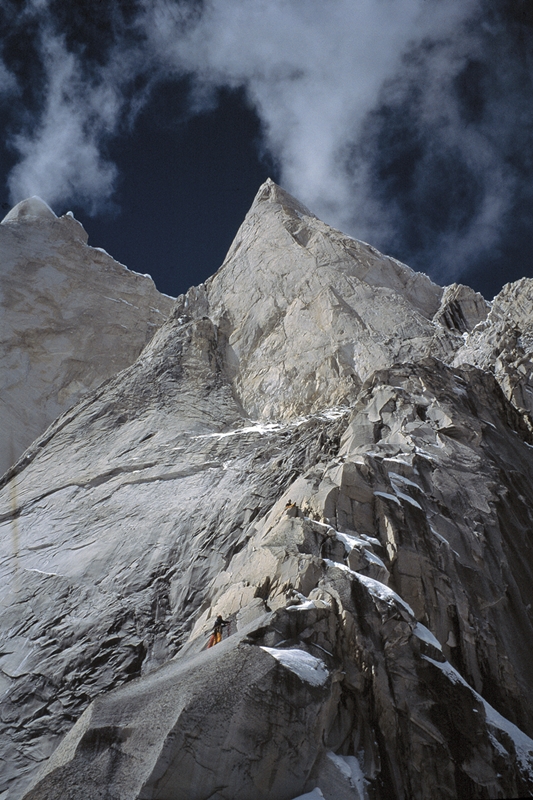
Owain Jones and myself on our first attempt to climb Meru Shark’s Fin, India. On the second attempt, Jules Cartwright, Jamie Fisher and I reached the base of the corner system at the top left of the snow-patch, directly beneath the final headwall. Pic Credit, Jules Cartwright.
2.
Slovak Direct (aka Czech Direct; Alaska Grade 6: 5.9, 100 degrees, 9,000′, Adam-Korl-Krizo, 1984).
Adamant that I was staying in North Wales trad climbing on rock for the summer, I twice refused Andy Houseman’s plea for a partner to go to Alaska. Andy is a Yorkshire man and drives a hard bargain. On the first phone call he told me his sponsors would fund the logistics and food. I turned him down. On the second phone call he told me his sponsors would fund the logistics and the food and the flight. I turned him down; I really wanted to rock climb in Wales. On the third phone call I made the mistake of asking what it was he wanted to climb in Alaska, he replied, “The Slovak Direct on Denali,” immediately I replied I was in and there followed yet another summer of lost rock climbing ambitions.

Myself climbing the third pitch of ‘The Corner’ on the Slovak Direct, Denali, Alaska. Pic credit, Andy Houseman.
3.
Chang Himal, North Face, Nepal. (ED+: M6, 1800m, 6802m)
Climbing in the mountains is not only about the climb and the situation, as important is the person I climb alongside. Andy Houseman, a quiet and understated Yorkshireman, is without question one of my closest friends, but beneath that pale Yorkshire exterior is something of a stubborn pugilist. A year after we had everything robbed while attempting a new route on Peak 41 in the Hinku Valley, Nepal, Andy came back with, “Let’s go and try Chang Himal.” It had been featured in Alpinist Magazine, in an article written by Lindsay Griffin, as one of the worlds most desirable unclimbed objectives. He took our total failure in 2008 and rolled the dice on an even bigger gamble in 2009. The gamble came good.
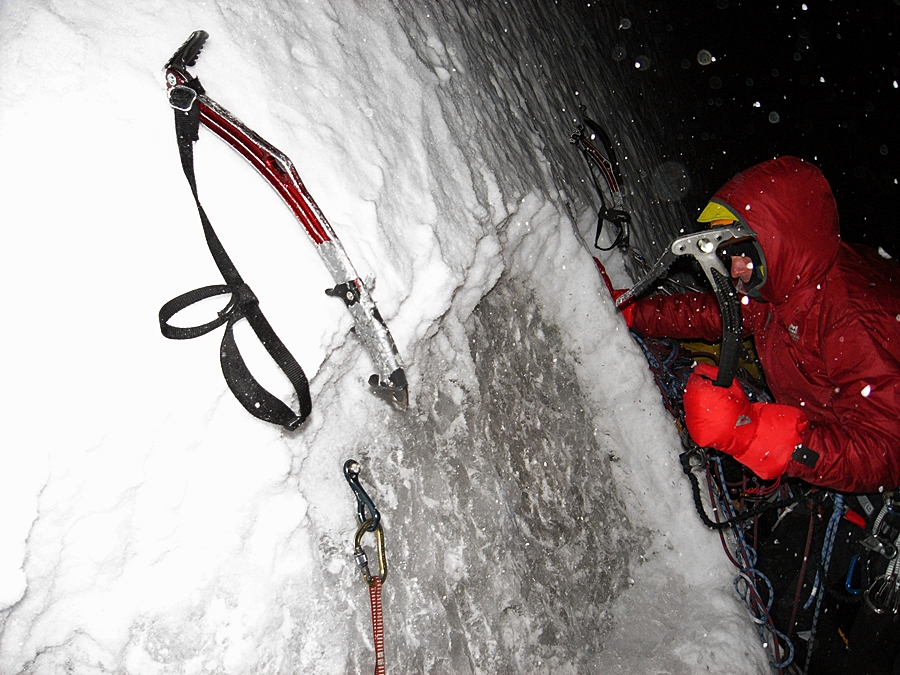
Andy Houseman at about 9pm involved in chopping the bivi ledge at the end of climbing on day two, this was as big as it got. We climbed for another full day, before a third bivi at approximately 6500m. We summited on day four before returning to the high bivi and a fourth night on the hill. This climb and summit was one of those moments, there was no false summit, no higher spot to stand, no rising ridge – we stood on the very top, very happy we could climb no higher, very happy for once to be able to say, “Yes, we reached the top.” Sometime in the night on day five we reached the base of the face and bivied before returning to camp the next morning. Pic credit, Nick Bullock
4.
North Face of Mt Alberta. Canada. House-Anderson (WI5+ M8 R/X, 1000m, 3619m)
After seven trips to Canada where I have been fortunate to climb many of the big multi-pitch ice and mixed lines, I decided it was time to taste some true Canadian. In 2014, Will Sim and I climbed the second ascent of the House-Anderson on Mt Alberta’s North Face. Will had lost his belay plate and we couldn’t find the ‘correct’ rappel to place us beneath the face, so we constructed our own anchors and committed. We carried food and gas for one night only and bars for two days and took no sleeping bags or mats, but we did have big jackets. I carried a bivi bag and Will carried synthetic trousers. Three days later, in the afternoon, we stumbled back into the tin shed of the Alberta Hut. The following day we retraced our steps back to the trusted and underpowered Nissan Micra parked on the Icefields Parkway, where the food bag in the boot was first port of call.
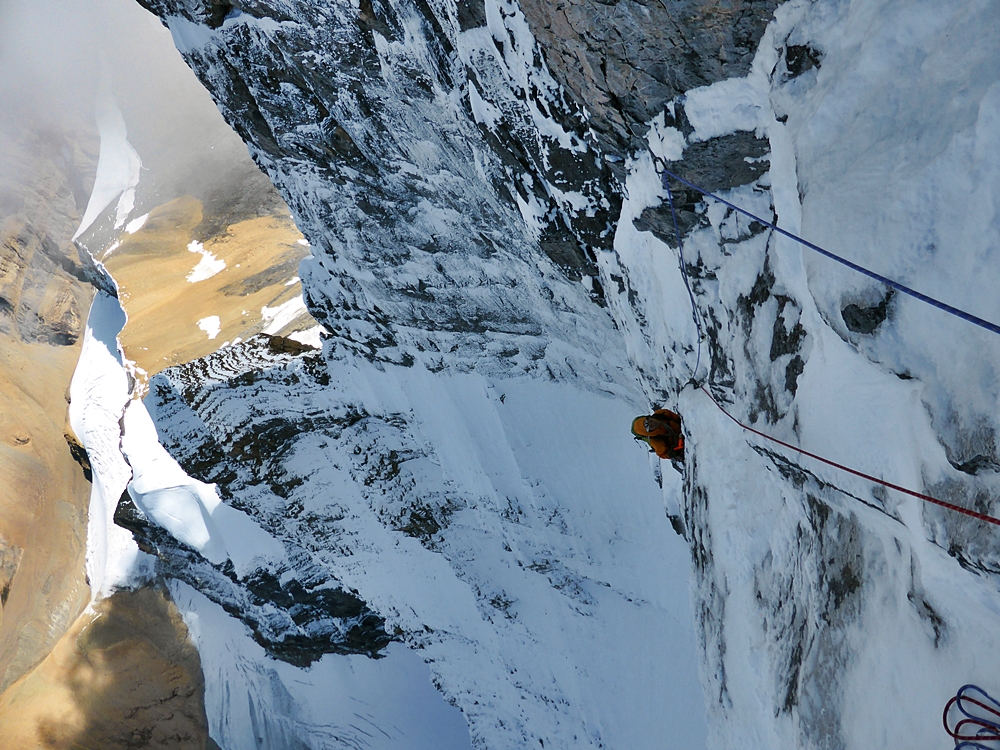
Will Sim seconding one of the ‘easier’ higher pitches of the House/Anderson, Mt Alberta. The weather deteriorated as we reached the summit crest, making the descent in the dark and the bad weather something of an effort. Will did a great job of finding the way, but at about 11pm, unable to find the correct gully on the massive and complex east face, we resorted to a second night out, but instead of a comfortable cave we had a blizzard beneath separate boulders. Pic credit, Nick Bullock.
5.
Jirishanca, Southeast Face,Huayhuash, Peru. Fear and Loathing (ED3: 900m that joins the East Buttress route, 6094m).
I shared five expeditions with Al Powell, four to Peru and one to Nepal, and I can honestly say we never had a cross word, well, almost never. My stopping and hanging from a dubious spike on our first climb together, a new route on Quitaraju’s south Face in Peru was the closest. I have more respect for Powell and what he stands for than possibly anyone. His passion and honesty are exemplary, though in 2003 he may have held some facts back from Sima, his partner, when we returned to Jirishanca’s Southeast Face and succeeded in climbing the line we later called Fear and Loathing. Powell, a highly regarded endurance runner designed and manufactured much of the gear for the attempt, he was adamant that a lightweight approach was the only way because a year before we were both almost killed when hit by a large slough sending us four-hundred feet while entering the gully near the base of the face.
We set out to climb the face on our alpine style, three-day attempt with packs weighing five kilos’ each, only to be stopped approximately one-hundred-and-fifty metres short of the summit by bad weather. The nagging concern that we were already very extended and spending a night, just beneath the summit in hope of better weather, would be a risk too far, we returned to our high bivi, before escaping the face the day after by constructing abseil anchors from ice v-threads.
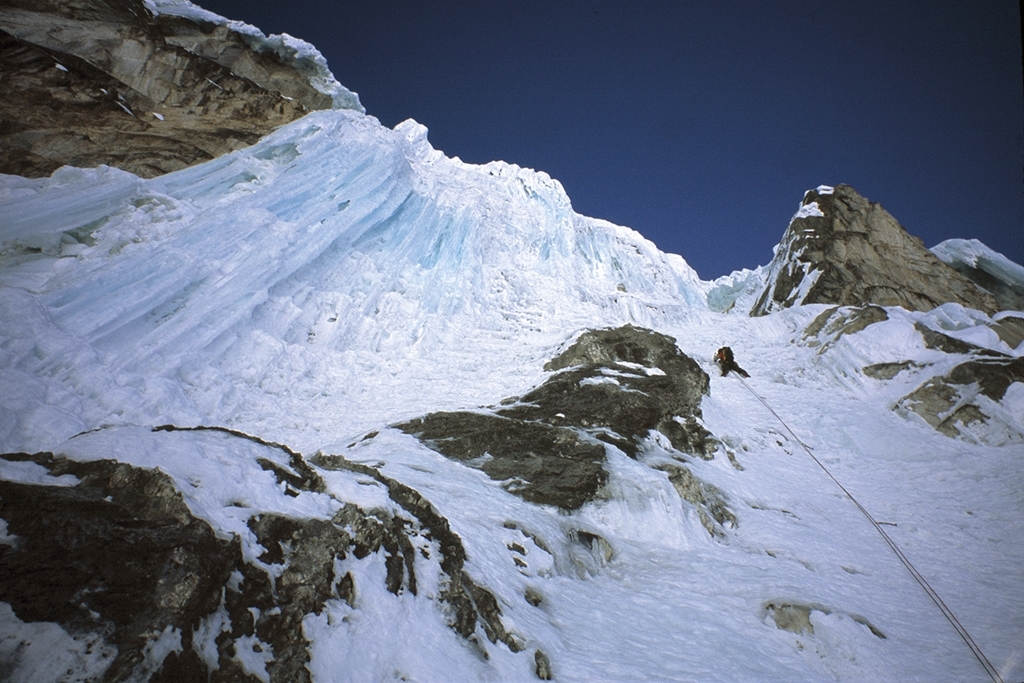
Myself leading towards the right side of the crux icefall on Jirishanca’s Southeast Face. Powell weighed our rucksacks before we set off, they were 5kg each. This included all bivi gear and food, although the food was a few fun sized chocolate bars, a single cup-a-soup and a small pack of noodles for each day. The rack was a few cams, a few nuts, a few ice-screws. We took no bolts or aid gear, we fixed no ropes. Pic Credit, Al Powell.
6.
Mick Fowler’s Helmet Boiler, Mousetrap Zawn, Gogarth, Anglesey. E5 5c
Tim Neill is a 6’7” mountain guide originally from Northern Ireland and a great friend. The list of Welsh rock climbs we have climbed together since first meeting in 1998 is long. Tim is one of the few friends who can say he saved my life after one particularly harrowing episode on a climb called The Bells, the bells! A million climbs behind us, and still we hadn’t learnt, or maybe Tim had, I was leading the crux pitch of another Gogarth route, this time a Mick Fowler climb called Helmet Boiler with the moderate grade of E5. The crux pitch weaved through unprotected overhanging mud, cheese, talc and quartz with small islands of sanity from which I could stand and question the wonders of what I was doing. Snapping quartz at the most run out point nearly ended the attempt and me, but a Bruce Lee snatch for a hold saved the day.
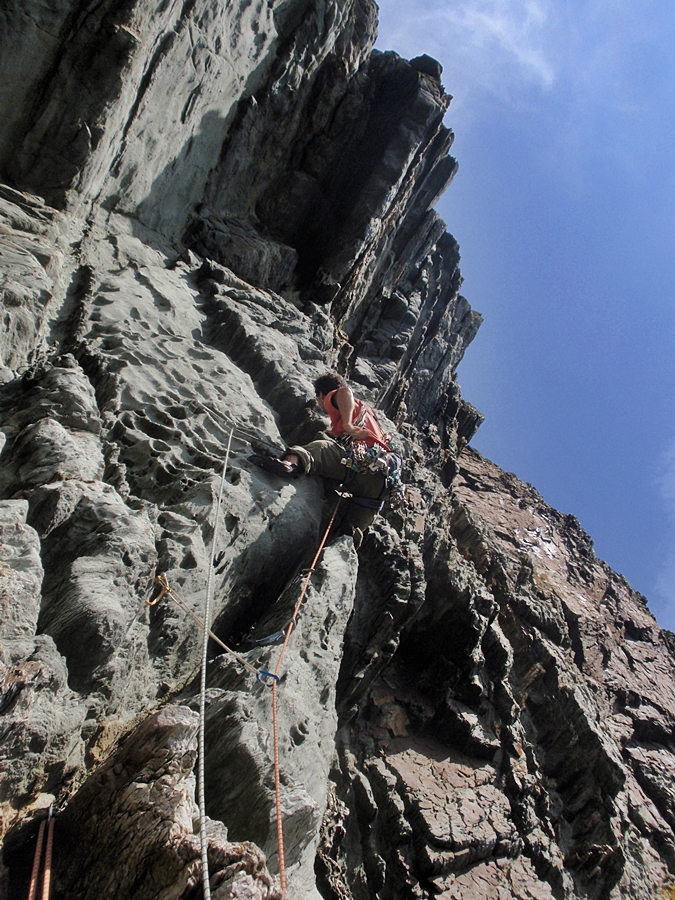
Myself starting pitch two of Helmet Boiler and I remember the climbing that day as if it was a few hours ago. Pic credit, Tim Neill.
7.
Godzilla. Beinn Bhàn’s, Coire Nan Fhamair and the Giants Wall. Scotland. IX/8
In March 2011, almost at the end of another Scottish winter, Guy Robertson and Pete Benson individually called me on the phone. “We are going in search of a new route on the Applecross cliffs, you can join us if you want.” I hadn’t had my fill that winter and drove the eleven-hour journey from Llanberis in North Wales to the north west of the Scottish Highlands by myself before settling down in the back of my green Citroen Berlingo to wait. At 10pm a car pulled up and the almost-mythical team of Scottish winter new route success came-a-knocking, bringing with them zeal and reconstituted meat in the form of such highland delights as sausage and pie, of which I partook in none.
After four hours we set off in the dark aiming for Beinn Bhàn’s, Coire Nan Fhamair and the Giants Wall.
Several hours later, the three of us topped out with a monster of a new line and monster smiles. The moon lit the glistening sheet of the green sea and the stars flickered almost the end of my winter that year. Scottish winter climbing and the style we impose on ourselves to keep it real can be very rewarding, especially when shared with trusted friends. We named the new route Godzilla and gave it a grade of IX/8.
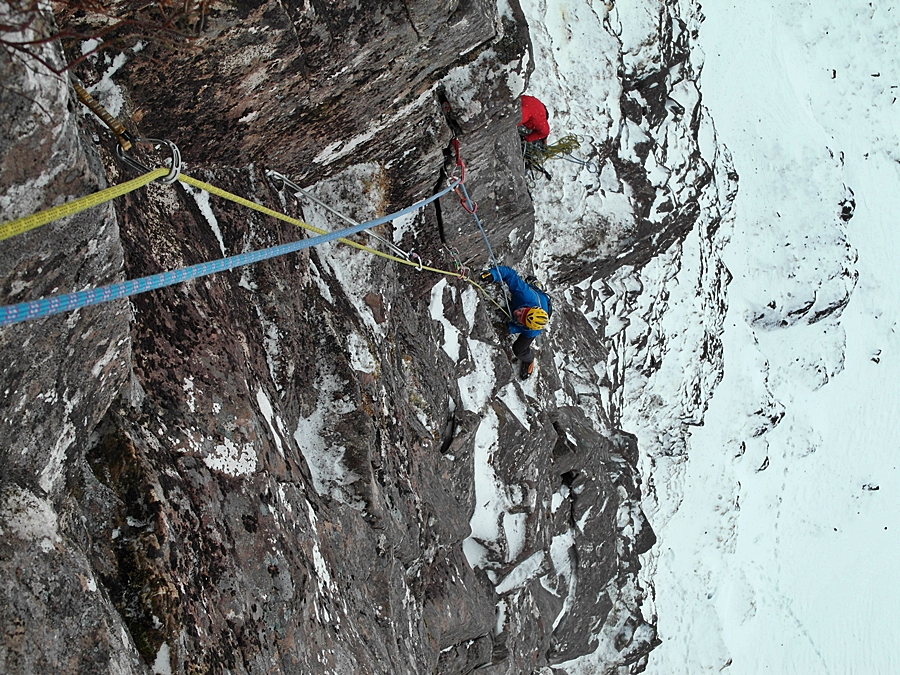
Guy Robertson seconding what turned out to be the crux pitch of Godzilla. To call this pitch the crux may suggest the other five pitches were easy, this would be doing the climb a disservice, as they were all quite chunky. Godzilla is up there with the best new routes and days climbing I have ever had in winter in Scotland, what gets better, walk-in, look-up, begin to climb, finish at the top, in the dark and with two great friends. Pic credit, Nick Bullock.
8.
Guerdon Grooves. Slime Wall. Buachaille Etive Mòr. (The one that got away. Bonus words and picture that didn’t appear on the Alpinist takeover.)
“Nick, I’ve been training hard and climbing easy routes and I’m getting nervous and jittery and I’m borderline ANGRY! We will go to Buachaille Etive Mòr.” This was how the phone call with my friend Guy Robertson finished after planning for the following day of Scottish winter climbing. Guy, a Scot and guru of all things wintery, was joining Bayard Russel, an East Coast American and me as we attended the final day of a BMC Winter International Meet.
Saturday morning, walking in the dark past Lagangarbh, the SMC hut and over iced puddles cracked like stars, we look up and a vision from a dream appears, there is a white wave running down Slime Wall. Guy turned to me, “It’s on, it’s on, my God, ITS ON!” As Guy had not actually said what the plan was, I could only guess that whatever it was, was on.
I had always dreamed of climbing the mythical, Guerdon Grooves, first climbed by Dave Cuthbertson and Arthur Paul in 1986 and not having had a second ascent. Climbers whispered when they spoke of it. At the start of each winter internet forums always had a long thread guessing the grade and asking would it ever be climbed in winter again. Guerdon was a fable, a dream, it was a rabbit from a hat, it was a step into the almost unknown and because of this, because of this unknown, this step, it was worth more than gold, but it couldn’t be taken at any cost, that would have been heresy.
Guy, Bayard and I started to climb at 10am armed only with a large rack of gear and a route description and with each move, with each pick placement, every front point, the anticipation and history and myth increased. The crux of this climb was coping with the folklore that threatened to weigh us down.
At six pm, all three of us stood on the top, the route was climbed. Robbo’s anger was quelled, Bayard, knowing nothing about the history of the climb thought it had been “An awesome outing dude”, but I could tell it was a little lost on him, and for me – well, I was almost over-whelmed with deep joy but I was also a little bit sad.


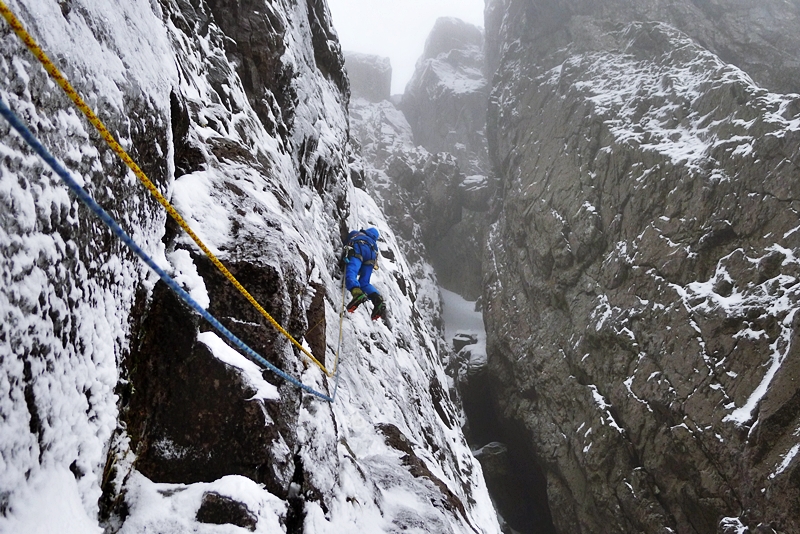
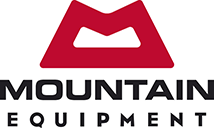







Who said: “It also appears posting on Facebook and filling a newsfeed about your amazingly fun life – every climb, every move, every amazing ‘adventure’ is the way forward. I really wonder what has happened to humility and being humble or even just getting on with your thing without sharing everything to the world.”
Answer. The same guy who said:”Recently I had a series of photographs, with each photograph accompanied by a paragraph of writing, featured on the Alpinist Magazine social media sites, Facebook, Instagram and Twitter.”
Be amazed if this gets published.
j
Hi John,
Nice to know you are still out there. Yes, like I say, its my problem and I’m working on it, thanks for once again pointing out my inadequacies.
All the best
Nick